
Peds-Gastrointestinal

Pediatric Acute Appendicitis
Teenage male presenting with abdominal pain worsening over 24 hours, diagnosed with acute appendicitis via POCUS.
The clip shows a circular structure which measures at 6.5 mm transversely, representing an acutely inflamed appendix with surrounding anechoic free fluid.
POCUS Acute Appendicitis: noncompressible, diameter >6mm, single wall >3mm are direct signs of appendicitis. Use of POCUS for diagnosis of acute appendicits significantly reduces cost and radiation exposure for patients without sacrificing diagnostic accuracy.
Contributor: C. Malcolm Roberson, MD. @ProjectUltraEM

Appendicitis (2/2) - Transverse
11 y/o M presented with 1 day of periumbilical pain that migrated to the right lower quadrant with nausea, vomiting and anorexia. Ultrasound with high frequency linear probe demonstrates an enlarged appendix with an external diameter of 1.32 cm with trace free fluid posteriorly, as well as a fecalith at the proximal end of the appendix. Surgery was consulted who requested a formal US which was non-diagnostic. Surgery took the patient anyway, and MRI confirmed our findings (including the large diameter).
Diagnostic criteria for appendicitis: a non-compressible, aperistaltic, blind ended structure >6mm diameter. Visualizing free fluid, tenderness in that area, and visualizing a fecalith can also add to the diagnosis.
See the evidence atlas for more info about POCUS diagnosing appendicitis but when visualizing a diagnostic appendicitis, it carries a positive likelihood ratio of 9.24. PMID: 28214369
Jackie Chiou MS4, Dr. Matthew Riscinti and Dr. Tian Liang - Kings County Emergency Medicine
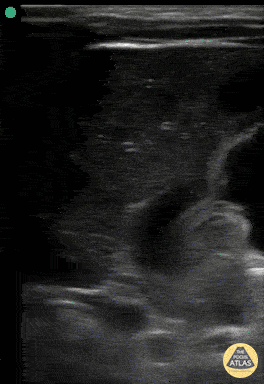
Pyloric Stenosis
Pyloric Stenosis
4 w/o male with forceful vomiting with each feed. Clip fans through hypertrophic pylorus measuring 14mm in diameter and channel length 24mm. It also shows a fluid filled stomach and the "antral nipple sign" - outpouching of pyloric tissue into antrum.
The "Pi" π = 3.1415 mnemonic for ballpark measurement cut-offs.
>3mm diameter of single muscular wall
>14mm transverse diameter of pylorus
>15mm channel length
Lilly Bellman, MD - PEM /US fellow Harbor-UCLA
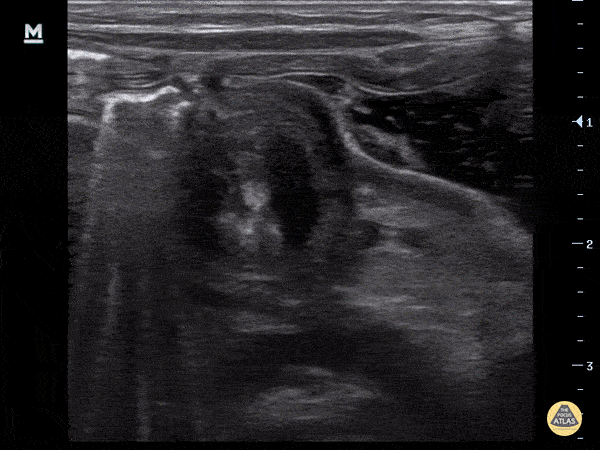
Pyloric Stenosis (Transverse)
4-week-old, vomiting intermittently for 2 weeks, seen PCP 3 days ago, reassured. Revisit today and PCP concerned for pyloric stenosis, so referred to ED. Exam in ED reassuring for well-appearing neonate.
In ED, POCUS completed revealing hypertrophic pyloric stenosis. Pylorus muscle hypertrophied and thickened in both transverse and logitudinal view. Transverse view demonstrates the classic target sign seen in pyloric stenosis.
Dr. Sathya Subramaniam, Pediatric EM Fellow - Kings County/SUNY Downstate

Meckel's Diverticulum
2 year-old male with history of constipation presented with one episode of painless hematochezia that occurred 1 hour prior to arrival. He had a benign abdominal exam. POCUS revealed a focal fluid collection in the RLQ with a bowel wall appearance containing a hyperechoic focus, most suspicious for a Meckel’s diverticulum with fecalith. Surgical resection and pathology confirmed a Meckel's diverticulum.
Dr. Kelly McWilliams, PGY-2, Denver Health Residency in Emergency Medicine
Dr. Anna Abrams, Pediatric Emergency Medicine Fellow, Childrens Hospital Colorado
Dr. Jon Orsborn, Director of Pediatric POCUS, Childrens Hospital Colorado

Pyloric Stenosis - Antral Nipple Sign
3 week old with projectile vomiting, POCUS showed positive astral nipple sign which is a highly specific finding for pyloric stenosis - the redundant pyloric mucosa protrudes into the gastric antrum. The measurements show increased pyloric muscle thickness (>3mm) and increased pyloric longitudinal measurement (>15 - 17 mm)
Measurements can be remembered using "Pi Rule"
- Pyloric muscle thickness, i.e. diameter of a single muscular wall on a transverse image >3 mm
- Pyloric transverse diameter >14 mm
- Pyloric longitudinal measurement >15 - 17 mm
Contributed by:
Dimitri Livshits DO, Ultrasound Fellow; Jane Belyavskaya MD, Ultrasound Fellow; Chris Hanuscin MD, Ultrasound Division Director (Kings County/SUNY Downstate)
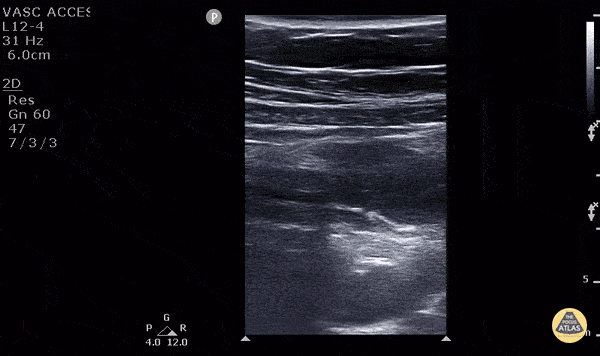
Appendicitis (1/2) - Longitudinal
11 y/o M presented with 1 day of periumbilical pain that migrated to the right lower quadrant with nausea, vomiting and anorexia. Ultrasound with high frequency linear probe demonstrates an enlarged appendix with an external diameter of 1.32 cm with trace free fluid posteriorly, as well as a fecalith at the proximal end of the appendix. Surgery was consulted who requested a formal US which was non-diagnostic. Surgery took the patient anyway, and MRI confirmed our findings (including the large diameter).
Diagnostic criteria for appendicitis: a non-compressible, aperistaltic, blind ended structure >6mm diameter. Visualizing free fluid, tenderness in that area, and visualizing a fecalith can also add to the diagnosis.
See the evidence atlas for more info about POCUS diagnosing appendicitis but when visualizing a diagnostic appendicitis, it carries a positive likelihood ratio of 9.24. PMID: 28214369
Jackie Chiou MS4, Dr. Matthew Riscinti and Dr. Tian Liang - Kings County Emergency Medicine

Pyloric Stenosis - Antral Nipple Sign with Measurements
3 week old with projectile vomiting, POCUS showed positive astral nipple sign which is a highly specific finding for pyloric stenosis - the redundant pyloric mucosa protrudes into the gastric antrum. The measurements show increased pyloric muscle thickness (>3mm) and increased pyloric longitudinal measurement (>15 - 17 mm)
Measurements can be remembered using "Pi Rule"
- Pyloric muscle thickness, i.e. diameter of a single muscular wall on a transverse image >3 mm
- Pyloric transverse diameter >14 mm
- Pyloric longitudinal measurement >15 - 17 mm
Contributed by:
Dimitri Livshits DO, Ultrasound Fellow; Jane Belyavskaya MD, Ultrasound Fellow; Chris Hanuscin MD, Ultrasound Division Director (Kings County/SUNY Downstate)

Appendicolith
Transverse view of the appendix showing the appendix with intraluminal appendicolith.
Contributor: Maher M. Abulfaraj, MD, @mahermabulfaraj

Ascites
Ascites with floating bowel and questionable to-and-fro peristalsis.
Contributor: Peter Gutierrez, MD, FAAP, Emory University School of Medicine/Children's Healthcare of Atlanta, @pocuspete

Pseudokidney Sign - Intussusception
23 month old with ileocolic intussusception. Pseudokidney sign seen here due to oblique orientation of the linear transducer.
Contributor: Antonio Riera, MD

Esophageal FB
5 yo male presents with swallowed decorative marble. no difficulty breathing. unable to handle secretions. POCUS shows an esophageal FB that was later removed by surgery.
Contributor: Paul Khalil, MD Nicklaus Children's Hospital, @khalil3paul

Neuroblastoma
18 mo F sent from PMD for mass in the RUQ. POCUS shows extra renal mass consistent with neuroblastoma that was later confirmed by pathology.
Contributor: Paul Khalil, MD Nicklaus Children's Hospital
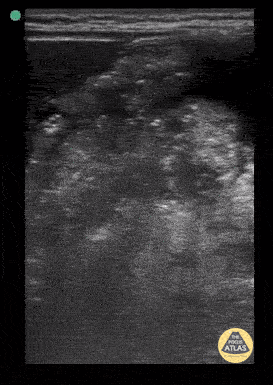
Full stomach 1
Gastric content eval for patient undergoing procedural sedation. With the patient in the right lateral decubitus position the linear probe is placed in a subxiphoid sagittal axis with the probe marker towards the head. The stomach is seen immediately caudal to the liver. The class 5 layer bowel wall of the stomach can be seen containing large volume, mixed echogenicity content.
Contributor: Matthew Moake, MD PhD
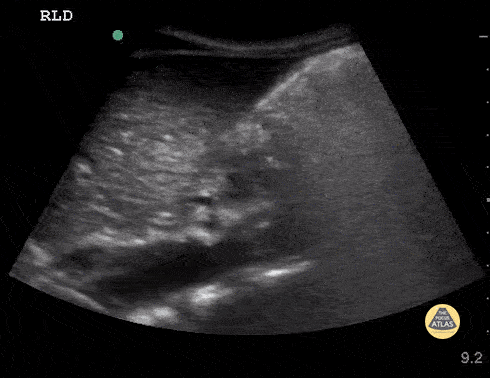
Full stomach 2
Ultrasound used to assess gastric content prior to procedural sedation. Sagittal view in the epigastric region using the curvilinear probe with the patient in the right lateral decubitus position. Probe indicator cephalad. The gastric antrum is seen in the upper right with heavily air-admixed content with dirty shadow obscuring deeper content. The liver is seen in the upper left and the aorta in the deep field.
Contributor: Matthew Moake, MD PhD

Pyloric Stenosis 1
Roughly 1m male with projectile emesis. POCUS demonstrated elongated and thickened pylorus with absence of trans-pyloric flow.
Contributor: Matthew Moake, MD PhD

Pyloric Stenosis 2 (1/2)
2+ weeks projectile vomiting. Extreme lab abnormalities including Cl 67. CG4: 7.57/67/34/60, base excess >30, lactate 3.23. The pyloric channel is elongated, thickened, and has an absence of trans-pyloric flow.
Contributor: Matthew Moake, MD PhD

Pyloric Stenosis 2 (2/2)
2+ weeks projectile vomiting. Extreme lab abnormalities including Cl 67. CG4: 7.57/67/34/60, base excess >30, lactate 3.23. The pyloric channel is elongated, thickened, and has an absence of trans-pyloric flow.
Contributor: Matthew Moake, MD PhD
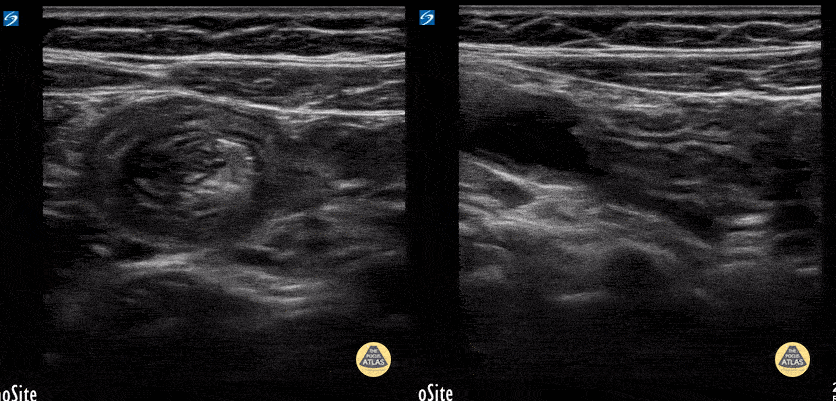
Ileo-ileal intussusception
7y female with N/V and tactile fever. Benign abdominal exam. Note the small size of the intuss. In long axis you can easily track the bowel wall as it folds into itself and see it is slowly sliding in and out a small bit.
Contributor: Matthew Moake, MD PhD

Ileo-ileal Intussuception 2
Toddler with colicky abdominal pain. LUQ with ileo-ileal intuss. Note the smaller size and active peristalsis of the intuss.
Contributor: Matthew Moake, MD PhD
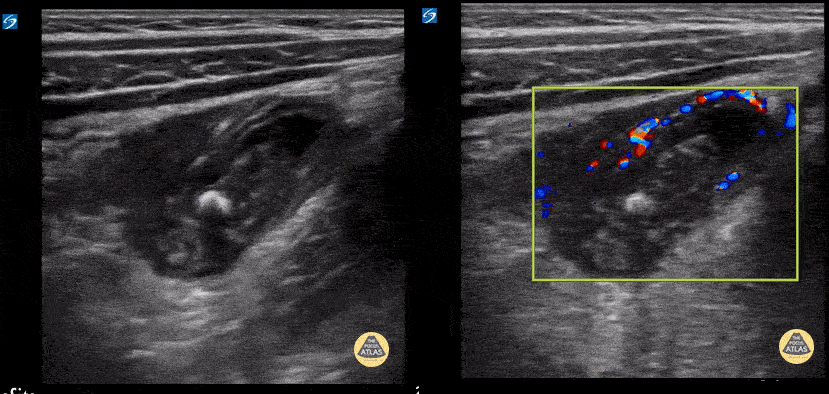
Ruptured Appendicitis
3y female with 3d RLQ abd pain, emesis, fever. WBC 8.5 with 73% PMN. CRP 9. POCUS with enlarged appendix with loss of bowel wall architecture, surrounding early fluid collection, fecolith, and mural hyperemia.
Contributor: Matthew Moake, MD PhD
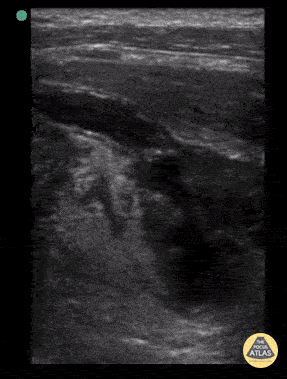
Ruptured Appendicitis 2
6y female with 2d abd pain, fever, nauesea, dysuria. OSH WBC 17.5, pyuria. Long axis view of the appendix draping down into the pelvis. Note how the regular bowel wall architecture is progressively obliterated as the appendix tracks distally into the pelvis, ending in full perforation with early abscess formation and surrounding hyperechoic fat.
Contributor: Matthew Moake, MD PhD
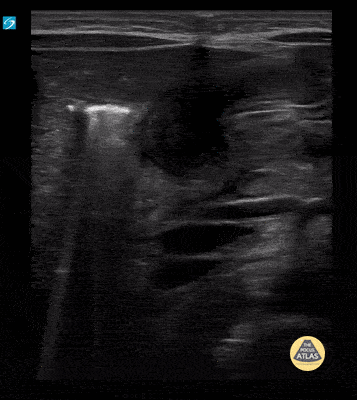
Pyloric Stenosis with and without measurements (1/4)
5 wk old male with projectile vomiting. Clips show hypertrophic pyloric stenosis in long axis.
Contributor: Paul Khalil, MD Nicklaus Children's Hospital @khalil3paul
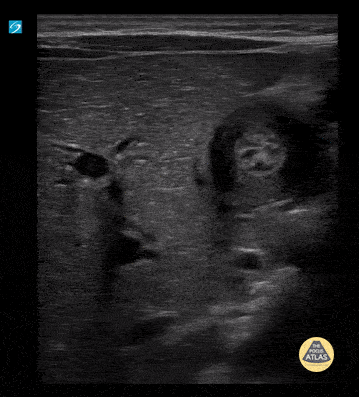
Pyloric Stenosis with and without measurements (2/4)
5 wk old male with projectile vomiting. Clips show hypertrophic pyloric stenosis in short axis.
Contributor: Paul Khalil, MD Nicklaus Children's Hospital @khalil3paul
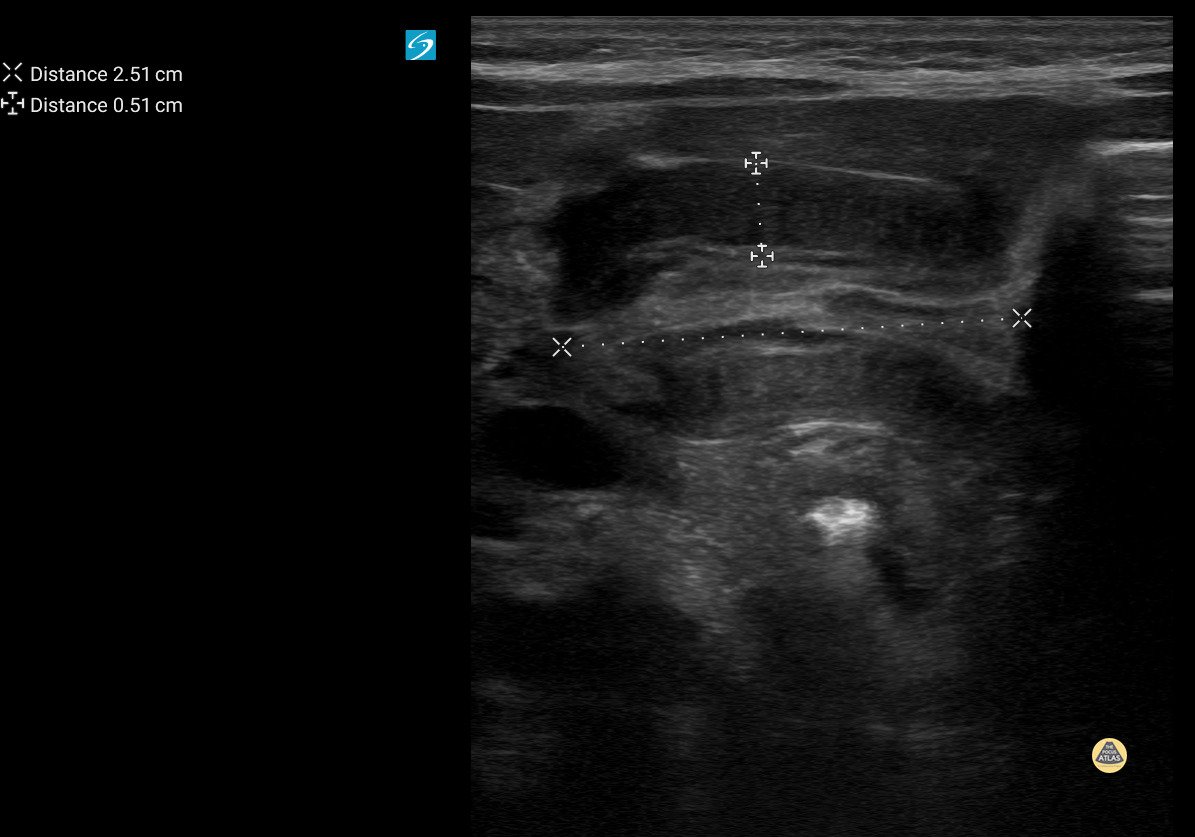
Pyloric Stenosis with and without measurements (3/4)
5 wk old male with projectile vomiting. Clips show hypertrophic pyloric stenosis in long axis.
Contributor: Paul Khalil, MD Nicklaus Children's Hospital @khalil3paul

Pyloric Stenosis with and without measurements (4/4)
5 wk old male with projectile vomiting. Clips show hypertrophic pyloric stenosis in short axis.
Contributor: Paul Khalil, MD Nicklaus Children's Hospital @khalil3paul
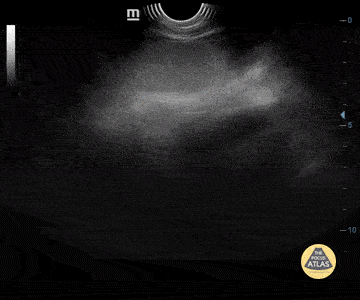
Dengue Ascites
4-year-old boy with severe dengue with free fluid in the abdominal cavity.
Contributor: Mg. Andres Silva Horna, Hospital Cayetano Heredia Piura-Peru

SBO
17 yo male with history of abdominal surgeries (g-tube and fundoplication) and chronic constipation who comes in with lower abdominal pain. POCUS shows stool to and fro (tanga sign).
Contributor: Paul Khalil, MD Nicklaus Children's Hospital @khalil3paul

Neurofibroma Abdominal Mass
3 yo presents with enlarging abdomen and mass palpated. A large abdominal mass was seen on POCUS. The kidney is seen directly below the mass in the image.
Contributor: Kathryn Pade, MD, Rady Children's Hospital San Diego
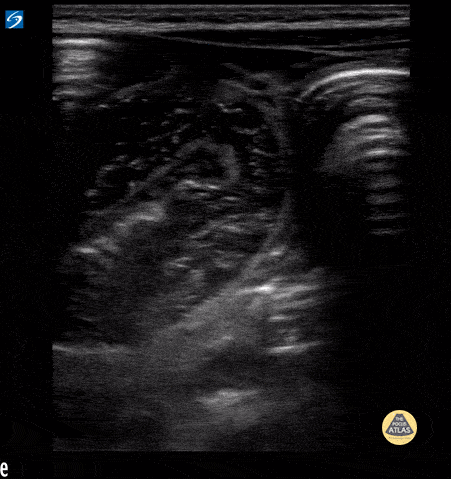
SBO
Small bowel obstruction with to and fro peristalsis visualized.
Contributor: Peter Gutierrez, MD FAAP FACEP; Children's Healthcare of Atlanta; @pocuspete

Ileocolic Intussusception
Ileocolic intussusception measuring 4.4cm.
Contributor: Peter Gutierrez, MD FAAP FACEP; Children's Healthcare of Atlanta; @pocuspete
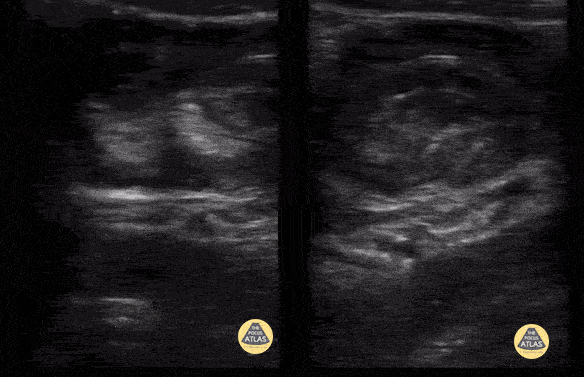
Ileocolic LUQ intussusception - Longitudinal & Transverse
3 yo male presented with an episode of abdominal pain and bilious emesis in the morning. He was noted to be sleepy all day at home and passed two bloody diarrheal stools prior to arrival. Point-of-care ultrasound demonstrates ileocolic intussusception in the left upper quadrant. Transverse view demonstrate a "target sign" and longitudinal view demonstrates "sandwich sign" consistent with the diagnosis.
Contributor: Megan Musisca, MD, Boston Children's Hospital
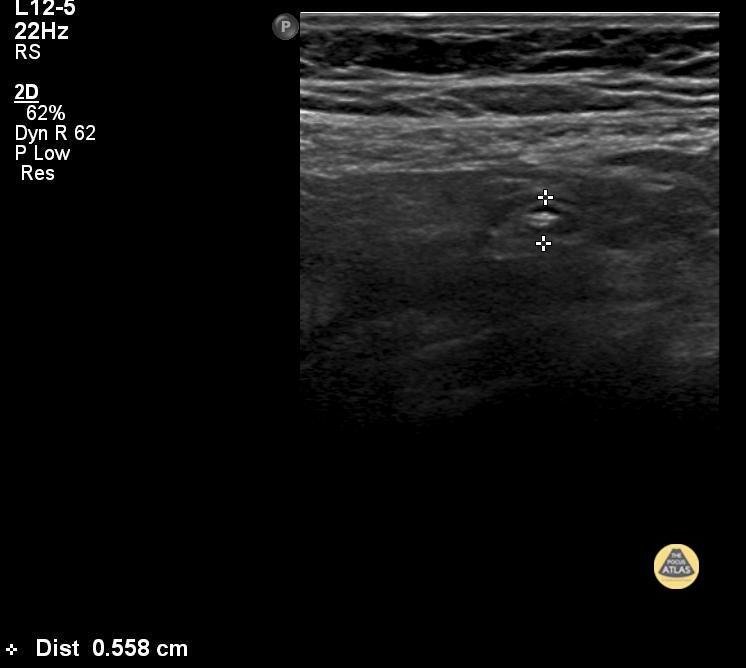
Appendicitis (1/3)
"Fever Vomiting and Abdominal pain 9yr old
Tenderness @ McBurney’s point
USG : Aperistaltic Dilated with probe tenderness in right iliac region Diameter 6mm plus"
Contributor: Dr Vanitha Jagannath

Appendicitis (2/3)
"Fever Vomiting and Abdominal pain 9yr old
Tenderness @ McBurney’s point
USG : Aperistaltic Dilated with probe tenderness in right iliac region Diameter 6mm plus"
Contributor: Dr Vanitha Jagannath
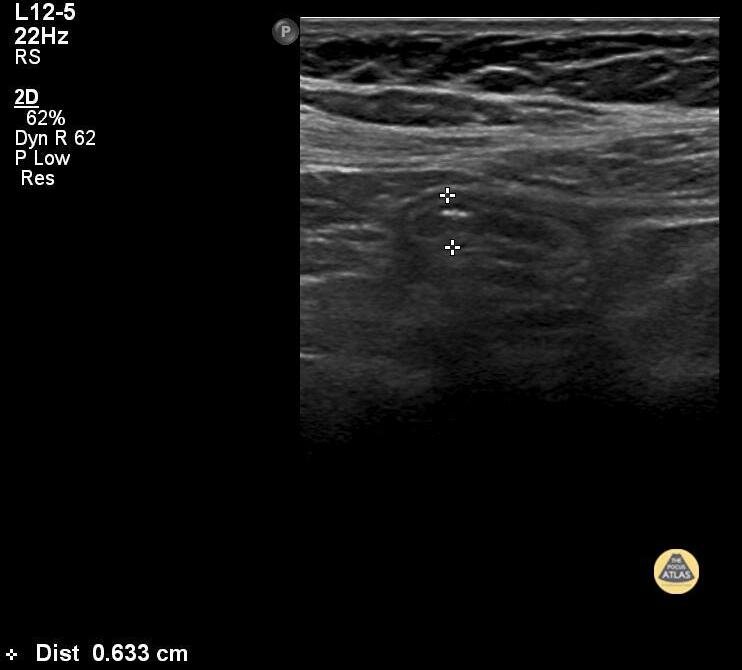
Appendicitis (3/3)
"Fever Vomiting and Abdominal pain 9yr old
Tenderness @ McBurney’s point
USG : Aperistaltic Dilated with probe tenderness in right iliac region Diameter 6mm plus"
Contributor: Dr Vanitha Jagannath
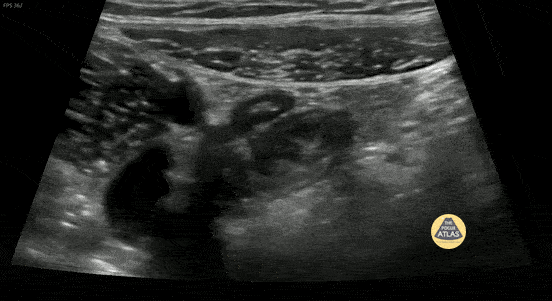
Normal Appendix 1 (1/3)
10 y/o with abdominal pain. Normal appendix identified medial to the iliac vessels. Please see other image in series for doppler.
Contributor: Elena Chen, MD
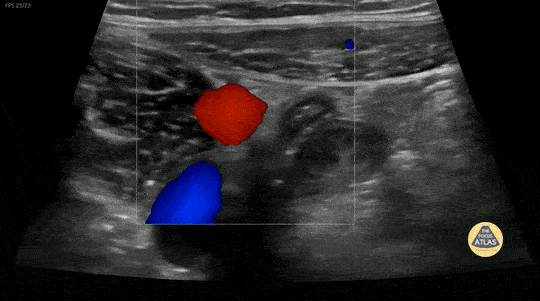
Normal Appendix 1 (2/3)
10 y/o with abdominal pain. Normal appendix identified medial to the iliac vessels.
Contributor: Elena Chen, MD

Normal Appendix 1 (3/3)
10 y/o with abdominal pain. Normal appendix identified medial to the iliac vessels.
Contributor: Elena Chen, MD

Normal Appendix 2 (1/2)
7 y/o F with abdominal pain. Normal appendix identified.
Contributor: Russ Horowitz, MD, Lurie Children's Hospital

Normal Appendix 2 (2/2)
7 y/o F with abdominal pain. Normal appendix identified.
Outer wall measured 0.48cm in long, 0.46cm in short, and 0.51cm again in a short axis.
Contributor: Russ Horowitz, MD, Lurie Children's Hospital
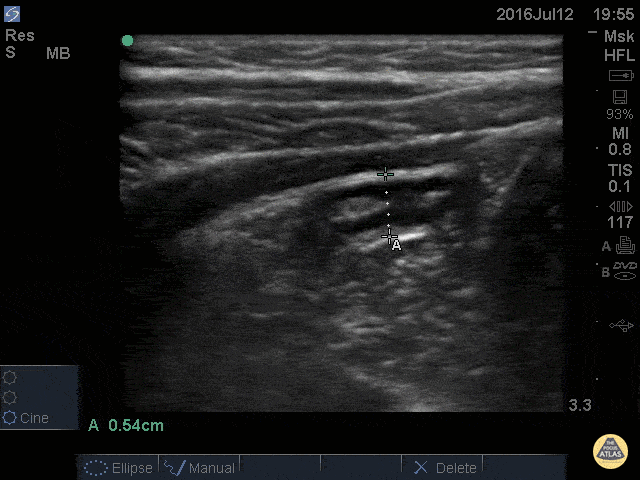
Normal Appendix - Cross Section Measured
14 y/o M with nausea vomiting and and RLQ pain. POCUS visualized a normal appendix is seen. A normal appendix is identified by a blind-ending tubular structure that is <6mm diameter measured from outer wall to outer wall (although 6mm-7mm has also been described). This patient’s appendix was measure to be 5.4mm.
Dr. Sathya Subramaniam - Children’s Hospital of Philadelphia
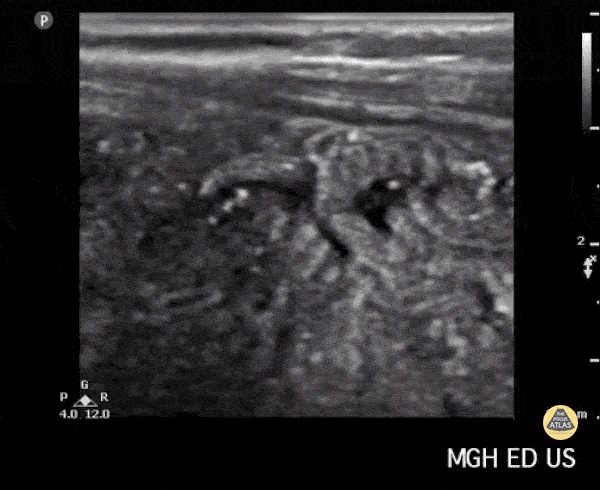
Ascariasis - "Sqworming in your belly is just ascaris as it sounds"
A two-year old with an intestinal nematode.
Andrew Liteplo MD, RDMS - Massachusetts General Hospital
Chief, Division of Ultrasound in Emergency Medicine
Director, Emergency Ultrasound Fellowship
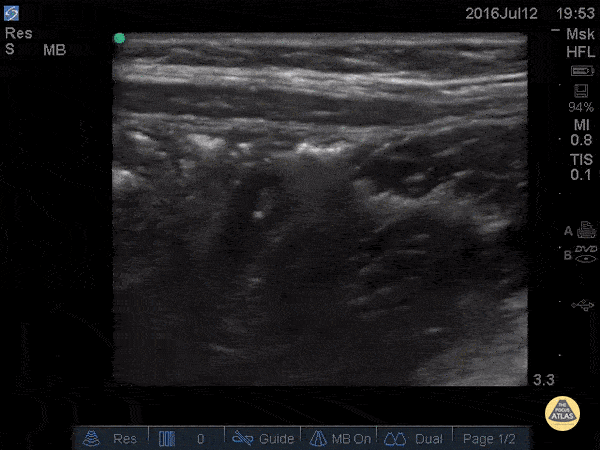
Normal Appendix - Cross Section
14 y/o M with nausea vomiting and and RLQ pain. POCUS visualized a normal appendix is seen. A normal appendix is identified by a blind-ending tubular structure that is <6mm diameter measured from outer wall to outer wall (although 6mm-7mm has also been described). This patient’s appendix was measure to be 5.4mm (see still image).
Dr. Sathya Subramaniam - Children’s Hospital of Philadelphia
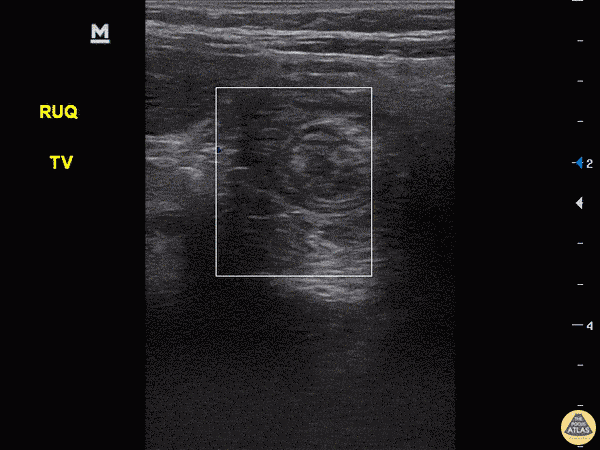
Intussusception with Target Sign
4-year-old child with vomiting since yesterday, seen in urgent care and was reassured. Today continued vomiting and mother came to ED. Mild tenderness over RUQ.
POCUS completed revealing intussusception. Target, Bulls Eye or Doughnut sign seen in the right upper quadrant, the most common region for an ileo-colic intussusception.
Dr. Sathya Subramaniam, Pediatric EM Fellow - Kings County/SUNY Downstate
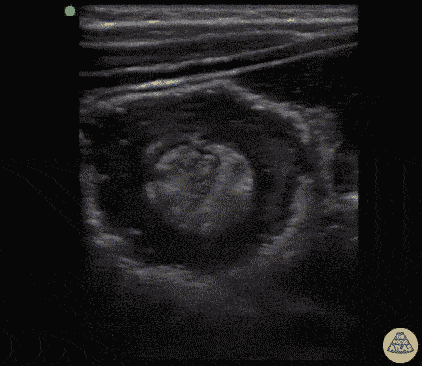
Intussusception with Target Sign
4-year-old with colicky abdominal pain, vomiting once this AM, on exam abdomen soft and non-tender and pt well-appearing.
POCUS performed demonstrating target sign. A hyperechoic fatty core can be seen within the intussuception inside hypoechoic edematous large bowel on both transverse and longitudinal views.
Dr. Sathya Subramaniam, Pediatric EM Fellow - Kings County/SUNY Downstate
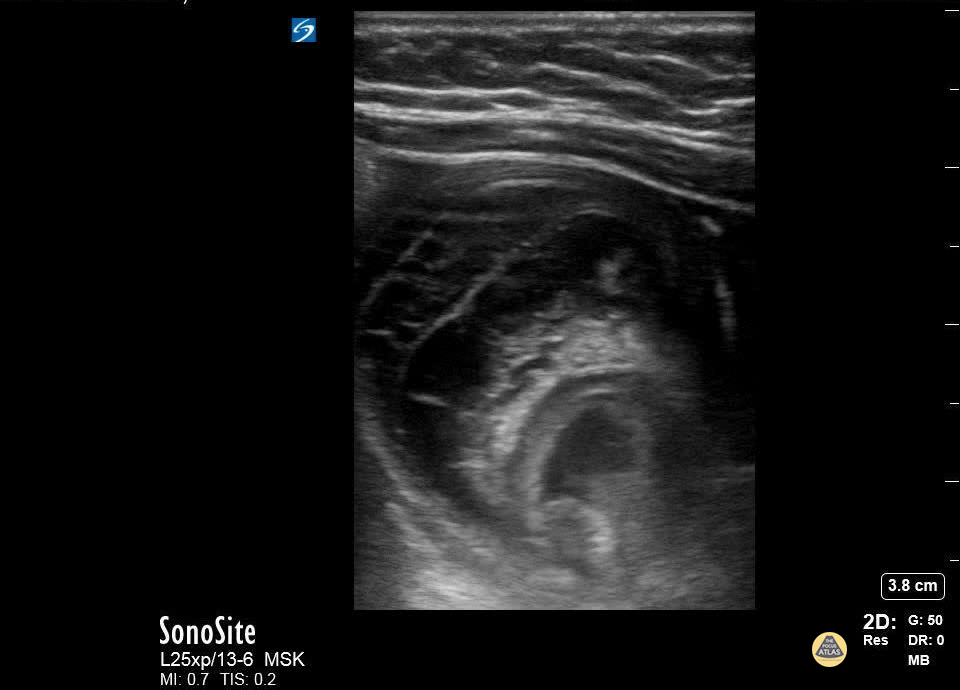
Intussusception - Colicky Abdominal Pain
This is a transverse view of the right upper quadrant of an infant who presented with several days of worsening colicky pain. He had decreased appetite, activity and vomiting. Bedside ultrasound revealed evidence of intussusception with extensive surrounding bowel edema likely secondary to delayed presentation.
Chris Heberer, DO EM PGY-3
CMU-Saginaw
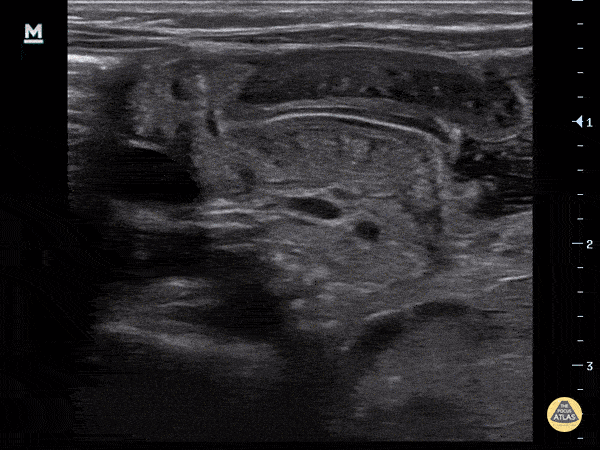
Pyloric Stenosis (Longitudinal)
4-week-old, vomiting intermittently for 2 weeks, seen PCP 3 days ago, reassured. Revisit today and PCP concerned for pyloric stenosis, so referred to ED. Exam in ED reassuring for well-appearing neonate.
In ED, POCUS completed revealing hypertrophic pyloric stenosis. Pylorus muscle hypertrophied and thickened in both transverse and logitudinal view. Transverse view demonstrates the classic target sign seen in pyloric stenosis.
Dr. Sathya Subramaniam, Pediatric EM Fellow - Kings County/SUNY Downstate
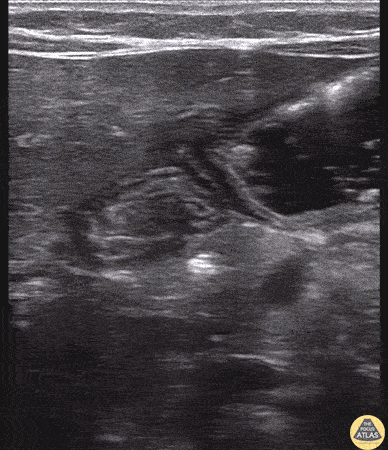
Pylorus (Normal)
4-week-old with vomiting, projectile according to parents. Infant tolerating formula feed well in ED. On exam well-appearing infant with soft abdomen and no masses to palpation.
POCUS reveals a normal appearing pylorus. Thickness of muscle < 3mm and length < 14mm. The patient was fed just before exam thus fluid can be seen swirling in the stomach. This can aid in visualization of the pylorus. Sometimes fluid can be seen passing through the pylorus.
Dr. Sathya Subramaniam, Pediatric EM Fellow - Kings County/SUNY Downstate

Normal appendix
A teenaged female presented with lower abdominal pain, and underwent POCUS to evaluate for appendicitis. A normal appendix was visualized. Seen here, the appendix is seen as a blind ending pouch with a hyperechoic outer border, a relatively hypoechoic wall, and relatively hyperechoic contents. The normal appendix should be less than 7cm in diameter and should be compressible. This patient ultimately was diagnosed with an alternate etiology of her abdominal pain.
Dr. Molly Thiessen
Denver Health Medical Center
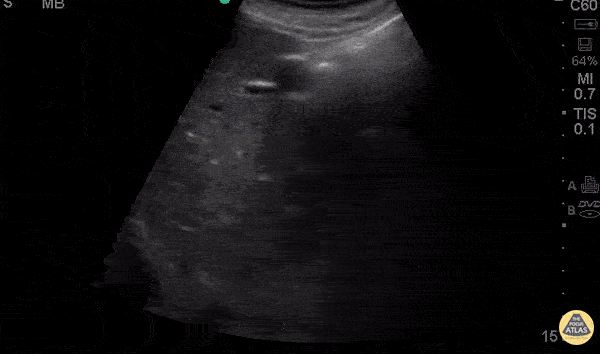
Splenic Sequestration
11 y/o F with PMH of sickle cell disease (ss) presents with 2 hours of tactile temperature, chest pain, and vague abdominal pain. Exam demonstrates normal vitals (T99.3) distended abdomen, nonspecific mild tenderness to palpation and enlarged spleen tip to the umbilicus. Ultrasound was used to confirm the size spanning nearly >15cm in length with heterogeneous echogenicity throughout the spleen consistent with splenic sequestration syndrome.
Dr. Praneetha Chaganti and Dr. Eddie Rodriguez - Kings County Emergency Medicine


















































